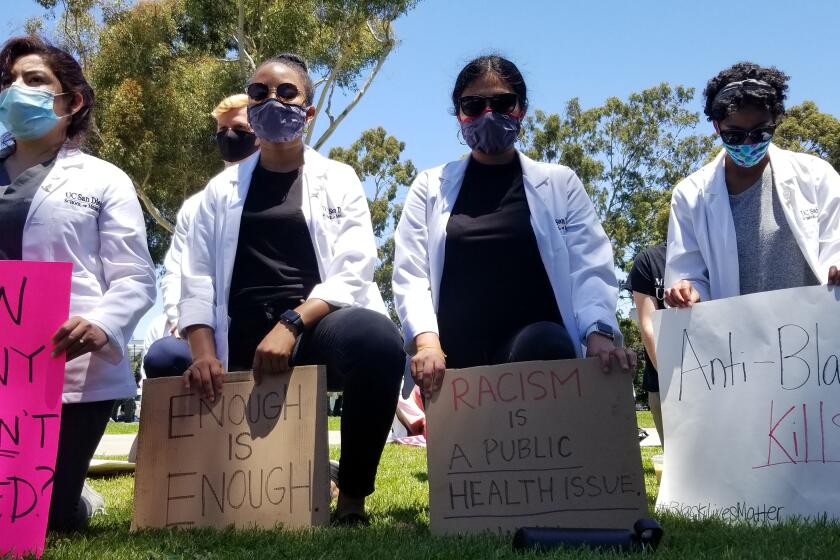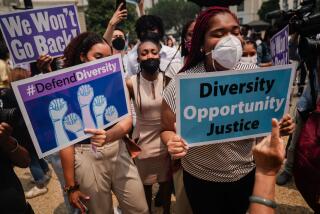Op-Ed: Medical bias can be deadly. Our research found a way to curb it

- Share via
Ask most any woman about her experience with the American healthcare system and you will likely hear stories of medical maltreatment in the form of dismissal, undertreatment or incorrect diagnosis. Add racial bias to the mix and a woman’s likelihood of being victimized in medicine is even worse.
In the largest study of its kind to date, a 2020 analysis of more than 3 million U.S. patients’ hospital admissions between 2012 and 2017 found that adults who are Black or from other underrepresented racial or ethnic groups received up to 10% fewer early treatments for heart problems than white patients. Medical bias according to race and gender is so powerful that even mega stars like Serena Williams have nearly died from it.
How would critical race theory translate to medical school curricula? For starters, race would be taught as a social, not a biological, construct.
Institutions including medical schools and hospitals have responded to the problem of bias with implicit bias training — the use of cognitive techniques to make people aware of their internalized assumptions about race and gender. But the data show that it doesn’t work. Being taught directly about one’s own internalized assumptions unfortunately doesn’t seem to alter behavior. So, what can we do about bias that is unconscious, pervasive and threatens the lives of millions of Americans?
In a study published this month in the journal Nature Communications, my colleagues and I discovered a surprisingly effective answer: an online group reasoning technique known as networked collective intelligence, which basically means getting doctors to exchange treatment options with one another. Think of it as a group chat for specialists.
We asked more than 800 practicing clinicians to provide treatment recommendations for either a white male or a Black female patient — portrayed by an actor in a video presentation — showing identical risk factors for cardiac disease. Initially, the Black female patient was over 200% more likely than the white male patient to be sent home rather than receive the guideline recommended care, which is referral to the emergency department.
So far, we had simply confirmed what the data from thousands of past cases had long established: There are significant disparities in doctors’ recommendations for patients of varying race and gender who present with identical risk factors.
Then things got interesting. We divided the clinicians into groups. A control group was given time to reflect in solitude on their decisions, as is standard practice in medical training, before getting the opportunity to revise their recommendations. Clinicians in the experimental group, meanwhile, had the same opportunity to revise their initial recommendations after contemplation. However, rather than doing so in solitude, they were able to exchange opinions within an “egalitarian” peer-to-peer network that makes the most of multiple doctors’ expertise.
Overdose deaths are skyrocketing in the U.S. and the increases are not being felt equally.
Our control group of clinicians showed no decline in bias. In fact, the only change we saw was a doubling in the rate of overtreatment for both patients, in the form of an unnecessary and risky surgical intervention. In peer networks, however, clinicians showed a remarkable shift. The rate at which the Black female patient was sent home dropped by 50%, while recommendations for the guideline-recommended treatment more than doubled.
The effects of bias on patient treatment vanished. There was no longer any disparity in care for the Black female and white male patients. Moreover, the rate of dangerous overtreatment for both the white male and Black female patient also dropped by half.
So how did it work?
In traditional medicine, physicians follow a strict hierarchy based on seniority, in which the most senior person has disproportionate influence over everyone else. Picture these networks as a fireworks explosion with the most senior person at the center. These networks do not foster an exchange of ideas. Instead, they act as a broadcast system for the beliefs and biases of the senior members. Those biases flow through the network to younger clinicians, who pass them on without any conscious recognition of bias.
Egalitarian networks, by contrast, shift knowledge and power from the individual to the collective. If the old hierarchies promote information like fireworks coming from a central source, peer-to-peer networks are structured like fishing nets with each point in the web connected directly to only a few others. The same people are in the network — junior and senior alike — but the structure makes everyone equal, filtering out errors on both sides and preventing any one person’s biases from dominating. In other words, the shift in clinicians’ recommendations was driven by the wisdom of the crowd.
While no single discovery or innovation can eradicate race and gender bias from medicine, using egalitarian networks to improve medical care could spark a badly needed paradigm shift, where we train future clinicians to seek answers through peer problem-solving networks rather than deferring to seniority. We have known for some time that biased norms in healthcare are reinforced and strengthened by traditional medical networks. But clinical networks can improve upon the traditional logic of medical authority by relying on collective intelligence, which can reduce flaws in clinical reasoning in a way individual approaches cannot.
It is long since time for the medical establishment to meet the modern era, stop viewing clinical reasoning as an individual act and use group reasoning to improve patient care.
Damon Centola is a senior fellow at the Leonard Davis Institute of Health Economics, professor of communication, sociology, and engineering at the University of Pennsylvania and author, most recently, of “Change: How to Make Big Things Happen.”
More to Read
A cure for the common opinion
Get thought-provoking perspectives with our weekly newsletter.
You may occasionally receive promotional content from the Los Angeles Times.












